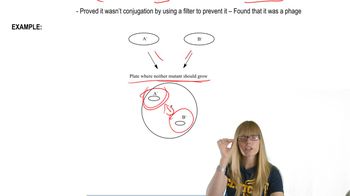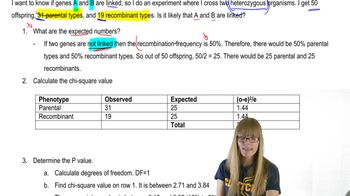How do we know that bacteriophages recombine genetic material through transduction and that cell-to-cell contact is not essential for transduction to occur?
Table of contents
- 1. Introduction to Genetics51m
- 2. Mendel's Laws of Inheritance3h 37m
- 3. Extensions to Mendelian Inheritance2h 41m
- 4. Genetic Mapping and Linkage2h 28m
- 5. Genetics of Bacteria and Viruses1h 21m
- 6. Chromosomal Variation1h 48m
- 7. DNA and Chromosome Structure56m
- 8. DNA Replication1h 10m
- 9. Mitosis and Meiosis1h 34m
- 10. Transcription1h 0m
- 11. Translation58m
- 12. Gene Regulation in Prokaryotes1h 19m
- 13. Gene Regulation in Eukaryotes44m
- 14. Genetic Control of Development44m
- 15. Genomes and Genomics1h 50m
- 16. Transposable Elements47m
- 17. Mutation, Repair, and Recombination1h 6m
- 18. Molecular Genetic Tools19m
- 19. Cancer Genetics29m
- 20. Quantitative Genetics1h 26m
- 21. Population Genetics50m
- 22. Evolutionary Genetics29m
5. Genetics of Bacteria and Viruses
Transduction
Problem 24d
Textbook Question
The phage P1 is used as a generalized transducing phage in an experiment combining a donor strain of E. coli of genotype leu⁺ phe⁺ ala⁺ and a recipient strain that is leu⁻ phe⁻ ala⁻. In separate experiments, transductants are selected for leu⁺ (Experiment A), for ala⁺ (Experiment B), and for phe⁺ (Experiment C). Following selection, transductant genotypes for the unselected markers are identified. The selection experiment results below show the frequency of each genotype.

In Experiment B, why are there no transductants with the genotype leu⁻ ala⁺?
 Verified step by step guidance
Verified step by step guidance1
Step 1: Understand the concept of generalized transduction. Generalized transduction occurs when a bacteriophage transfers random fragments of bacterial DNA from a donor strain to a recipient strain during infection. This process can result in the transfer of specific genes, such as leu⁺, phe⁺, or ala⁺, depending on the experimental selection criteria.
Step 2: Analyze the data from Experiment B. In this experiment, transductants are selected for ala⁺, meaning only recipient cells that acquire the ala⁺ gene from the donor strain are able to grow. The table shows that there are no transductants with the genotype leu⁻ ala⁺.
Step 3: Consider the genetic linkage between the leu and ala genes. Genetic linkage refers to the physical proximity of genes on the bacterial chromosome. If leu and ala are closely linked, it is likely that they are transferred together during transduction. This means that a recipient cell acquiring ala⁺ from the donor strain would also acquire leu⁺, resulting in the genotype leu⁺ ala⁺.
Step 4: Evaluate the absence of leu⁻ ala⁺ transductants. The lack of leu⁻ ala⁺ transductants suggests that the ala gene is not transferred independently of the leu gene. Instead, the transfer of ala⁺ is always accompanied by the transfer of leu⁺ due to their close genetic linkage.
Step 5: Conclude that the absence of leu⁻ ala⁺ transductants in Experiment B is due to the genetic linkage between leu and ala. This linkage ensures that any recipient cell acquiring ala⁺ from the donor strain also acquires leu⁺, preventing the formation of leu⁻ ala⁺ genotypes.
 Verified video answer for a similar problem:
Verified video answer for a similar problem:This video solution was recommended by our tutors as helpful for the problem above
Video duration:
2mPlay a video:
Was this helpful?
Key Concepts
Here are the essential concepts you must grasp in order to answer the question correctly.
Generalized Transduction
Generalized transduction is a process by which a bacteriophage (phage) transfers genetic material from one bacterium to another. During this process, the phage can accidentally package bacterial DNA instead of its own, which can then be introduced into a recipient bacterium upon infection. This mechanism allows for the transfer of any gene from the donor strain, making it a powerful tool for genetic studies.
Recommended video:
Guided course

Transduction
Selection of Transductants
In genetic experiments, transductants are selected based on specific traits conferred by the donor strain's genes. The selection process involves growing the recipient strain in conditions that favor the expression of the desired traits, such as the ability to synthesize certain amino acids. The absence of certain genotypes among the transductants can indicate the efficiency of gene transfer and the linkage of genes on the chromosome.
Recommended video:
Guided course

Transduction
Linkage and Genetic Mapping
Linkage refers to the tendency of genes located close to each other on a chromosome to be inherited together during meiosis. In the context of the experiments, the absence of the leu⁻ ala⁺ genotype in Experiment B suggests that the genes for leucine and alanine biosynthesis are closely linked. This linkage can affect the frequency of recombination events, leading to certain combinations being less likely to occur in the transductants.
Recommended video:
Guided course

Chi Square and Linkage
Related Videos
Related Practice
Textbook Question
430
views


